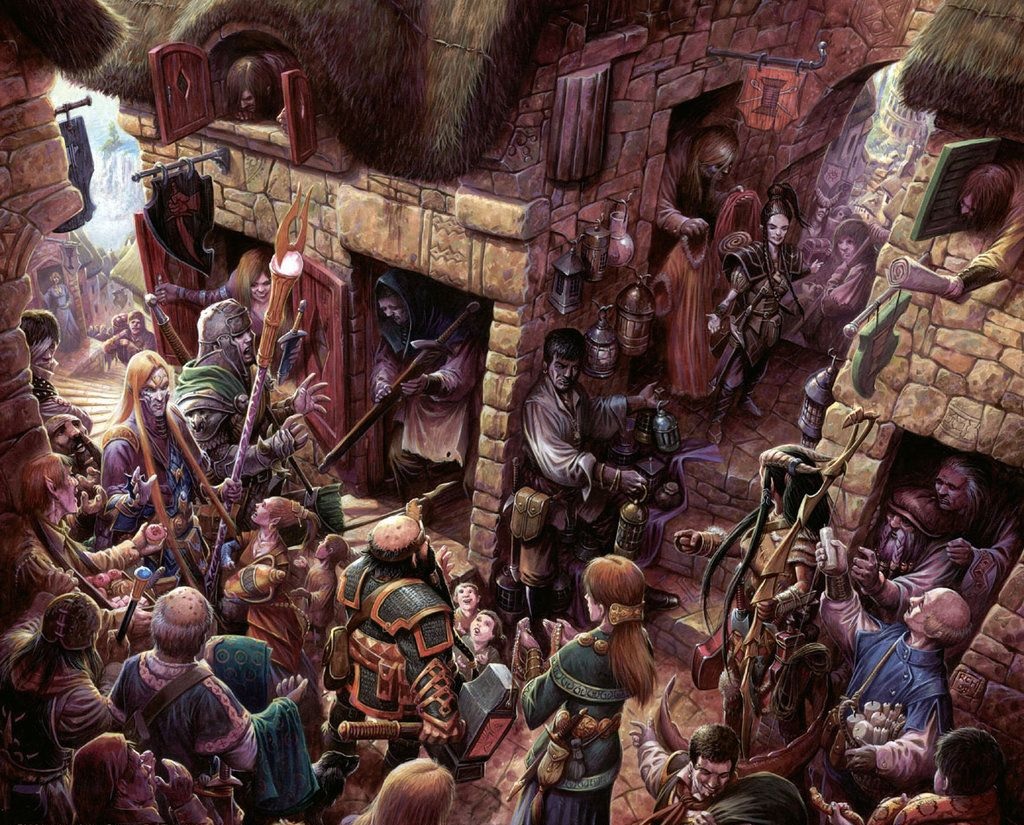Difference between revisions of "Urban (range)"
Tao alexis (talk | contribs) |
Tao alexis (talk | contribs) |
||
| Line 119: | Line 119: | ||
* [[Kobald]] | * [[Kobald]] | ||
* [[Manes]] | * [[Manes]] | ||
| + | * [[Mite]] | ||
* [[Rat (giant)]] | * [[Rat (giant)]] | ||
* [[Skeleton]] | * [[Skeleton]] | ||
Revision as of 18:58, 21 October 2023
Urban ranges are densely populated regions comprising not only concentrated towns or cities but, in some cases, villages as well. These areas are characterised by persons engaged in non-agrarian activities, though there may be small orchards or fields adjoined to a neighbourhood or a larger estate located within the urban area. The essence of urban life lays in the presence of its compact streets, buildings, sophisticated drainage systems for sanitation, sturdy masonry structures for defense and streets that are busy with people.
Urban ranges are designed to accommodate the influx of substantial quantities of food and raw materials, required for both sustenance and manufacturing. Economic activity gives rise to a dynamic akin to a great bellows, where the constant ebb and flow of ships, boats and wagons move goods in and out. Along riverbanks, quays and docksides are built to create bustling hubs for the collection and storage of commodities. Town squares and large storage areas link the urban area with the surrounding countryside, bringing in locals every day, who although do not live in the city, are well known to it.
The urban centre also serves as an administrative and defensive stronghold for the province or realm, with a substantial population dedicated to accounting, decision-making and maintaining order. Authority is decentralised between factions who are assigned to control different aspects and parts of the city or town; entities include the town guard and the town watch, nobles and the upper class, guilds and artisans, common labourers and the general poor, religious orders and individual churches, secret societies and cabals and learned persons and their students ... all competing for control over the general maelstrom of people. Each quarter and neighbourhood acts as a territory, where those in control defend their power. Conflicts, mostly controlled and carried out with subtle grace, sometimes burst into fits of violence that usually end quickly.
Conditions
If characters possess wealth, urban ranges offer the utmost safety. They can opt for a private room in a sovereign inn or take prestigious apartments in a well-regarded building. They may even buy their own house. So long as they remain on well-traveled avenues and mingle with the general population, they can rely on guards, societal norms and the influence of powerful acquaintances to ensure a life of refinement and tranquility. On a slightly humbler scale, they can live among the middle class — which though less opulent, is by no means uncomfortable or perilous. It's only in the slums and when among criminal elements that players should be cautious.
In market towns, nearly anything one desires can be obtained or at least ordered, though this may necessitate hiring agents and waiting months for delivery. Meanwhile, characters can enjoy dining, drinking, studying, learning a trade, engaging in business, speculating, participating in politics or pursuing numerous other activities as long as their finances permit.
Common Features
Below is a list of elements and features that are common to savanna ranges:
- Almshouse
- Apothecary
- Aqueduct
- Archery Range
- Arena
- Armoury
- Arsenal
- Avenue
- Bailey
- Bank
- Barracks
- Baths
- Black Market
- Bollard (see notes)
- Bridge
- Carter Post
- Castle
- Cathedral
- Combat Pit
- Courthouse
- Courtyard
- Court (space)
- Dry-dock
- Dump
- Fairs & Festivals
- Ferry
- Fishpond
- Flophouse
- Forge
- Fountain
- Garden
- Gong Pit
- Granary
- Graveyard
- Grocery
- Guardpost
- Guildhouse
- Harbour Tower & Spur
- Harbour
- Hospital
- Hostel
- Inn
- Keep
- Laboratory
- Lane
- Lavatory (see notes)
- Library
- Memorial
- Mews
- Mint
- Money Lender
- Monument
- Neighbourhood
- Office
- Palace
- Pharos
- Poster (see notes)
- Private Chapel
- Public Art
- Quarter
- Rat Catcher
- Reservoir
- School
- Sewer
- Shanty
- Slum
- Solar Observatory
- Stable
- Statue
- Stockyard
- Street Market
- Street Sign (see notes)
- Street
- Streetlamp (see notes)
- Tavern
- Temple
- Thaumaturgical School
- Theatre
- Tower
- Town Hall
- Town Wall
- University
- Villa
- Warehouse
- Well
- Workhouse
- Workshop
Urban Creatures
The following monsters may occupy reclusive spaces within urban areas, ranging from things commonly seen to very rare:
See List of Ranges
